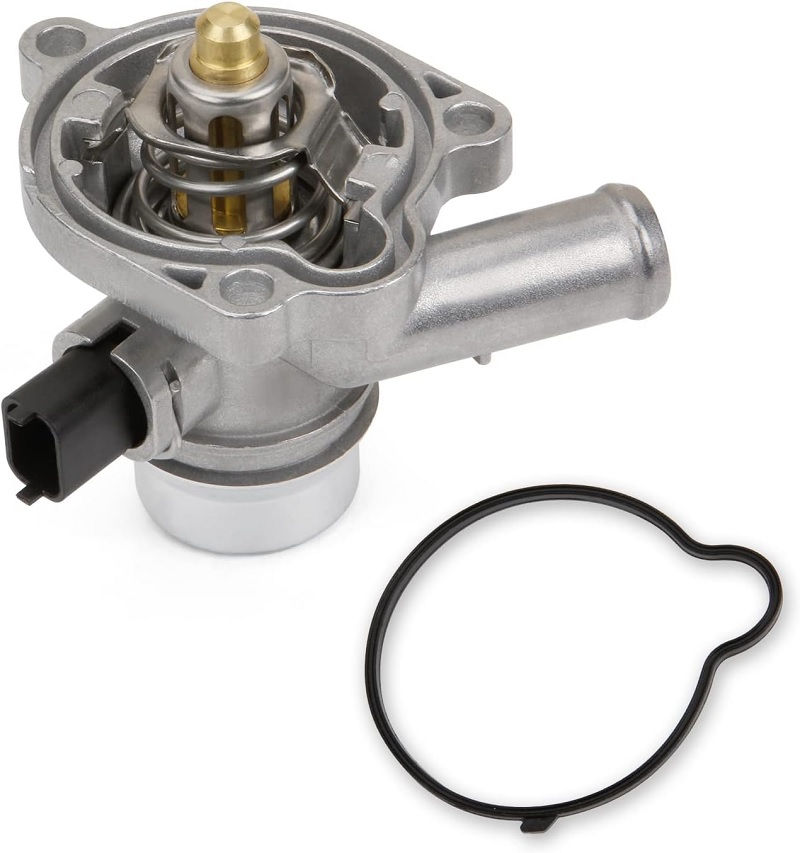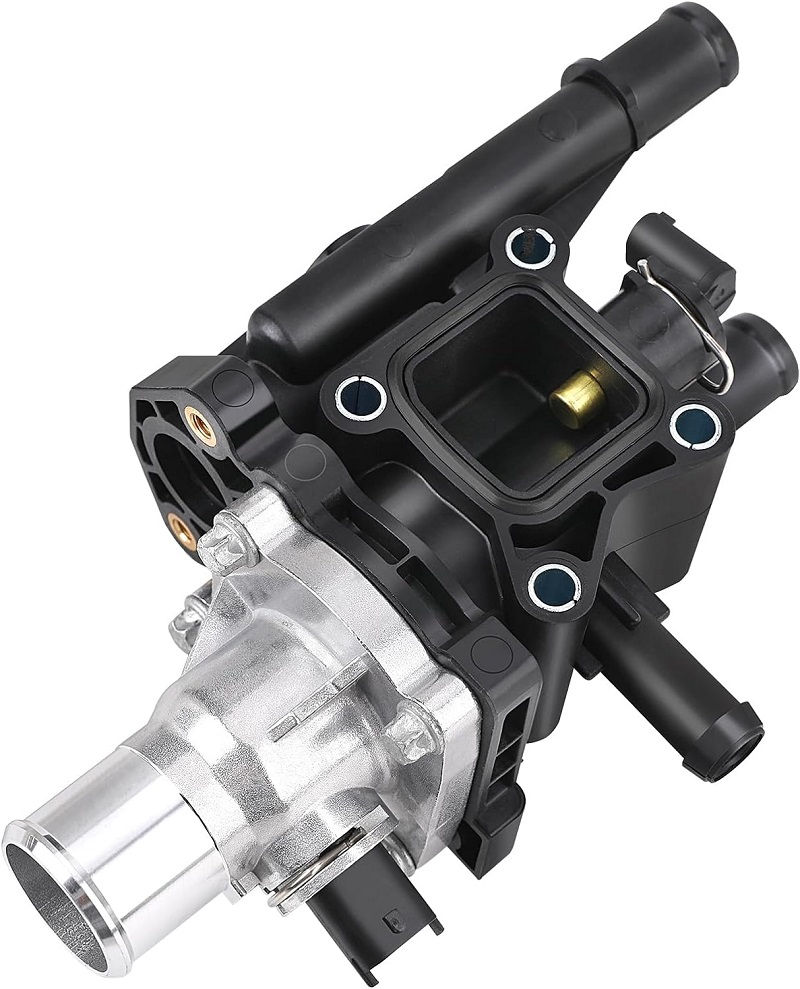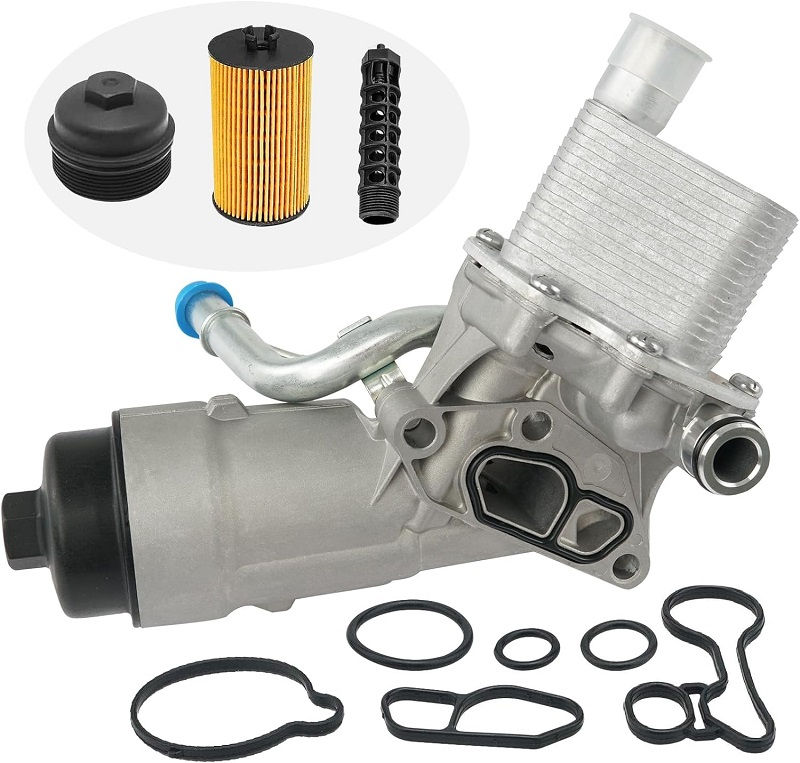This post contains affiliate links. This means I will make a commission at no extra cost to you should you click through and make a purchase [ “As an Amazon Associate, I earn from qualifying purchases.” ]. Read the full disclosure here.
2011 Chevy Cruze Thermostat GuideMechanic.Com Are you a proud owner of a 2011 Chevy Cruze? If so, then you’re probably aware of the importance of maintaining your vehicle’s thermostat.
The thermostat plays a vital role in regulating the engine’s temperature, ensuring optimal performance and preventing overheating.
In this comprehensive blog article, we will delve into the details of the 2011 Chevy Cruze thermostat, providing you with all the information you need to know to keep your vehicle running smoothly.
First, let’s start by understanding what a thermostat does and why it’s crucial for your Chevy Cruze. The thermostat acts as a valve that controls the flow of coolant through the engine.
It opens and closes based on the engine’s temperature, allowing coolant to circulate when the engine is warm and shutting it off when it’s cool.
This process helps maintain the engine’s ideal temperature range, ensuring efficient combustion and preventing potential damage.
The Importance of a Well-Functioning Thermostat

A properly functioning thermostat is vital for the overall health of your vehicle’s engine. Without it, the engine may overheat, leading to potential engine damage and costly repairs.
In this section, we will discuss the importance of a well-functioning thermostat and the potential consequences of neglecting its maintenance.
A well-functioning thermostat ensures that your engine operates within the optimal temperature range. When the engine is too cold, the thermostat remains closed, preventing coolant from circulating.
This allows the engine to warm up quickly, reducing wear and tear on the internal components. Once the engine reaches the desired temperature, the thermostat opens, allowing coolant to flow and maintain a consistent temperature.
See Also: Chevy Cruze Catalytic Converter
However, if the thermostat fails to open or close properly, it can cause various issues. If it gets stuck in the closed position, coolant won’t circulate, leading to overheating.
On the other hand, if it gets stuck in the open position, the engine may take longer to warm up, resulting in reduced fuel efficiency, poor performance, and increased emissions.
Regularly checking and maintaining your thermostat is crucial to prevent these problems and ensure your 2011 Chevy Cruze operates smoothly.
Signs of a Failing Thermostat

Is your 2011 Chevy Cruze experiencing temperature fluctuations or other warning signs? It could be an indication of a failing thermostat.
In this section, we will highlight the common symptoms of a faulty thermostat, helping you identify the issue early on and take necessary actions to resolve it.
1. Engine Overheating
One of the most apparent signs of a failing thermostat is engine overheating. If your temperature gauge consistently shows high readings or if you notice steam coming from under the hood, it’s likely that your thermostat is not functioning correctly. Overheating can cause severe engine damage, so it’s crucial to address the issue promptly.
2. Temperature Fluctuations
Another common indication of a failing thermostat is temperature fluctuations on the dashboard. If you notice that the temperature gauge rapidly goes from hot to cold or vice versa, it’s a clear sign of a thermostat problem. Inconsistent temperature readings can affect the engine’s performance and should not be ignored.
3. Coolant Leaks
Leaking coolant is often a result of a faulty thermostat. If you find puddles of coolant under your vehicle or notice a sweet smell coming from the engine compartment, it’s essential to investigate further. Coolant leaks not only affect the thermostat’s functionality but can also lead to engine overheating and damage.
4. Poor Fuel Efficiency
A thermostat that is stuck open can cause your engine to run cooler than necessary, resulting in poor fuel efficiency. If you notice a sudden decrease in your 2011 Chevy Cruze’s fuel economy, it’s worth checking the thermostat as it could be the culprit behind this issue.
5. Heater Problems
A failing thermostat can also impact the performance of your vehicle’s heating system. If you’re experiencing insufficient heat or no heat at all when you turn on the heater, it’s worth considering that the thermostat may be malfunctioning.
See Also: Chevy Cruze Mass Air Flow Sensor
The thermostat regulates the flow of coolant to the heater core, which is responsible for providing warm air to the cabin.
How to Test Your Thermostat

If you suspect that your 2011 Chevy Cruze thermostat is not functioning properly, it’s essential to perform a diagnostic test.
This section will guide you through the step-by-step process of testing your thermostat, allowing you to determine whether it needs replacement or just a simple repair.
1. Gather the Necessary Tools
Before you start testing the thermostat, make sure you have the required tools on hand. You’ll need a pair of pliers, a multimeter, a bucket or container to collect coolant, and a thermometer.
2. Safely Cool Down the Engine
Ensure that the engine has cooled down before starting the diagnostic process. Opening the radiator cap or working with hot coolant can cause severe burns, so take the necessary precautions to avoid any accidents.
3. Locate the Thermostat
The thermostat is usually located near the engine, connected to the upper radiator hose. Refer to your vehicle’s owner manual or consult online resources to find the precise location of the thermostat in your 2011 Chevy Cruze.
4. Remove the Thermostat
Once you’ve located the thermostat, you’ll need to remove it for testing. Start by disconnecting the negative terminal of the battery to prevent any electrical mishaps.
Then, carefully remove the thermostat housing using the pliers or a socket wrench, depending on the design of your thermostat housing.
5. Test the Thermostat
Now that you have the thermostat in your hands, it’s time to test its functionality. Start by placing the thermostat in a container filled with water.
Use the multimeter to measure the resistance of the thermostat at different temperatures. The resistance should change as the temperature of the water increases or decreases. Refer to the manufacturer’s specifications to ensure the readings are within the acceptable range.
6. Replace or Repair the Thermostat
If the thermostat fails the diagnostic test or shows readings outside the specified range, it’s time to consider a replacement.
In some cases, a faulty thermostat can be repaired by cleaning or adjusting it, but it’s often more practical to replace it entirely to ensure optimal performance.
Replacing a Faulty Thermostat
If your diagnostic test confirms that your thermostat needs replacement, fear not! This section will walk you through the process of replacing a faulty thermostat in your 2011 Chevy Cruze. With clear instructions and handy tips, you’ll be able to tackle this task confidently and efficiently.
1. Gather the Required Tools and Materials
Before you begin replacing the thermostat, gather all the necessary tools and materials. You’ll need a new thermostat, a gasket or sealant, a socket wrench or pliers, a scraper or sandpaper, and a container to collect coolant.
2. Safely Cool Down the Engine
Ensure that the engine has cooled down before starting the replacement process. Opening the radiator cap or working with hot coolant can cause severe burns, so take the necessary precautions to avoid any accidents.
3. Drain the Coolant
Locate the radiator drain plug or remove the lower radiator hose to drain the coolant into a container. Make sure to follow the correct procedure outlined in your vehicle’s owner manual to prevent any damage or spills.
See Also: 2015 Chevy Cruze Water Pump
4. Remove the Thermostat Housing
Once the coolant has been drained, locate the thermostat housing. Depending on your specific model, it may be secured with bolts or clips. Use a socket wrench or pliers to remove the housing and carefully take out the old thermostat.
5. Clean the Surfaces
Before installing the new thermostat, clean the surfaces where the housing and thermostat will be placed. Use a scraper or sandpaper to remove any residue or debris, ensuring a proper seal.
6. Install the New Thermostat
Place the new thermostat into the housing, making sure it fits correctly. Apply a gasket or sealant to ensure a tight seal. Then, carefully reinstall the thermostat housing, tightening the bolts or clips securely.
7. Refill the Coolant
After the thermostat and housing are securely in place, it’s time to refill the coolant. Refer to your vehicle’s owner manual for the correct coolant type and the appropriate fill level. Slowly pour the coolant into the radiator filler neck, ensuring that it reaches the recommended level.
8. Check for Leaks
Once the coolant is refilled, start the engine and let it run for a few minutes. Monitor for any signs of leaks or abnormalities.
Inspect the thermostat housing and connections to ensure everything is secure. If you notice any leaks, address them immediately before continuing to drive your 2011 Chevy Cruze.
Maintenance Tips for Your Thermostat
Prevention is always better than cure, and the same applies to your vehicle’s thermostat. In this section, we will provide you with essential maintenance tips to ensure the longevity and optimal performance ofyour 2011 Chevy Cruze thermostat. From regular inspections to coolant flushes, we’ve got you covered.
1. Regularly Inspect the Thermostat
Make it a habit to visually inspect your thermostat during routine maintenance checks. Look for any signs of wear, corrosion, or damage.
If you notice any issues, such as a cracked housing or a stuck valve, it’s best to replace the thermostat to prevent future problems.
2. Check Coolant Levels
Regularly check the coolant levels in your radiator and ensure they are at the appropriate level. Low coolant levels can lead to overheating and cause stress on the thermostat.
If you notice a significant drop in coolant levels, it may indicate a leak or another underlying issue that needs to be addressed.
3. Perform Coolant Flushes
Over time, coolant can become contaminated with debris, rust, or other impurities. Performing regular coolant flushes helps remove these contaminants and ensures that the coolant can flow freely through the engine and thermostat. Refer to your vehicle’s owner manual for the recommended interval for coolant flushes.
4. Use the Right Coolant
Using the correct type and quality of coolant is crucial for the optimal performance of your thermostat. Different vehicles have specific coolant requirements, so refer to your owner manual or consult with a trusted mechanic to ensure you’re using the appropriate coolant for your 2011 Chevy Cruze.
5. Inspect and Replace Hoses
Inspect the radiator hoses connected to the thermostat for any signs of wear, cracks, or leaks. Over time, hoses can deteriorate, leading to coolant leaks and potential thermostat issues. Replace any damaged or worn-out hoses promptly to maintain the integrity of your cooling system.
6. Maintain a Clean Radiator
A clean radiator allows for efficient heat exchange and proper cooling system function. Regularly inspect the radiator for any debris, dirt, or bugs that may obstruct airflow. Use a soft brush or compressed air to remove any obstructions and maintain optimal radiator performance.
7. Pay Attention to Warning Signs
Be vigilant for any warning signs that may indicate thermostat issues. If you notice fluctuating temperature readings, coolant leaks, or any other abnormal behavior, it’s essential to address the problem promptly. Ignoring warning signs can lead to more severe engine problems down the line.
8. Follow the Recommended Maintenance Schedule
Adhere to the manufacturer’s recommended maintenance schedule for your 2011 Chevy Cruze. Regularly scheduled maintenance, such as tune-ups and inspections, can help identify and prevent potential thermostat issues before they escalate into more significant problems.
See Also: 2014 Chevy Cruze Coil Pack
9. Consult a Professional Mechanic
If you’re unsure about performing thermostat maintenance or repairs yourself, it’s always best to consult a professional mechanic.
They have the knowledge and expertise to diagnose and address any thermostat-related issues accurately.
A mechanic can also provide guidance on proper thermostat maintenance techniques specific to your 2011 Chevy Cruze.
10. Keep an Eye on Your Vehicle’s Temperature
Pay attention to your vehicle’s temperature gauge regularly. Familiarize yourself with the normal operating temperature range for your 2011 Chevy Cruze.
If you notice any sudden or significant deviations from this range, it’s a good idea to investigate further and seek professional assistance if necessary.
Common Thermostat Problems and Solutions
Even with proper maintenance, thermostats can sometimes encounter issues. In this section, we will discuss common problems that may occur with your 2011 Chevy Cruze thermostat and provide you with effective solutions to resolve them.
1. Thermostat Stuck Closed
A thermostat that is stuck closed can prevent coolant from circulating through the engine, resulting in overheating. This can be caused by debris or sediment buildup, a faulty thermostat valve, or a damaged thermostat housing.
To resolve this issue, you may need to remove the thermostat and clean or replace it, depending on the severity of the problem. Additionally, inspect and clean the thermostat housing and ensure there are no obstructions.
2. Thermostat Stuck Open
A thermostat that is stuck open can cause the engine to take longer to warm up, resulting in reduced fuel efficiency and poor performance. This can be caused by a worn or damaged thermostat valve or a faulty thermostat spring.
To rectify the problem, you will likely need to replace the thermostat entirely. Ensure that the new thermostat is compatible with your 2011 Chevy Cruze and properly installed.
3. Incorrect Temperature Reading
If your thermostat is providing inaccurate temperature readings on the dashboard gauge, it may be due to a malfunctioning sensor or a faulty thermostat itself.
In this case, you may need to replace the sensor or the entire thermostat assembly, depending on the specific issue. Consult a professional mechanic for an accurate diagnosis and appropriate solution.
4. Coolant Leaks
Coolant leaks can occur in various parts of the cooling system, including the thermostat housing. Leaks can be caused by a damaged gasket, loose connections, or cracks in the housing.
Inspect the thermostat housing and associated components for any signs of leakage. If you detect a coolant leak, replace the faulty gasket or repair the damaged housing to prevent further leaks and ensure proper thermostat operation.
5. Improper Temperature Regulation
If you notice that your engine temperature is consistently outside the normal range or fluctuates erratically, it can indicate an issue with the thermostat’s temperature regulation.
This can be caused by a malfunctioning thermostat, a faulty temperature sensor, or a problem within the cooling system. Consult a professional mechanic to diagnose the exact cause and address the issue accordingly.
See Also: 2007 Toyota Camry Catalytic Converter
- P0000 Through P0099: Understanding OBD-II Trouble Codes - February 11, 2025
- P0000 Through P0199: Understanding OBD-II Trouble Codes - February 10, 2025
- P0080 Exhaust Valve Control Solenoid Circuit High (Bank 1) - February 9, 2025
